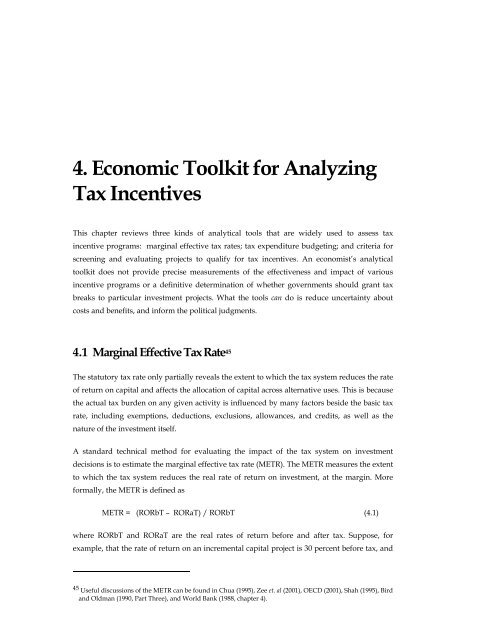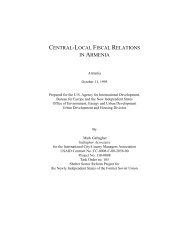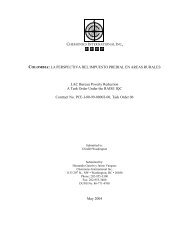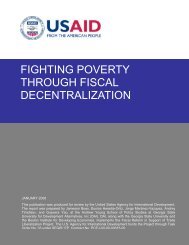Effectiveness and Economic Impact of Tax Incentives in the SADC ...
Effectiveness and Economic Impact of Tax Incentives in the SADC ...
Effectiveness and Economic Impact of Tax Incentives in the SADC ...
Create successful ePaper yourself
Turn your PDF publications into a flip-book with our unique Google optimized e-Paper software.
4. <strong>Economic</strong> Toolkit for Analyz<strong>in</strong>g<br />
<strong>Tax</strong> <strong>Incentives</strong><br />
This chapter reviews three k<strong>in</strong>ds <strong>of</strong> analytical tools that are widely used to assess tax<br />
<strong>in</strong>centive programs: marg<strong>in</strong>al effective tax rates; tax expenditure budget<strong>in</strong>g; <strong>and</strong> criteria for<br />
screen<strong>in</strong>g <strong>and</strong> evaluat<strong>in</strong>g projects to qualify for tax <strong>in</strong>centives. An economist’s analytical<br />
toolkit does not provide precise measurements <strong>of</strong> <strong>the</strong> effectiveness <strong>and</strong> impact <strong>of</strong> various<br />
<strong>in</strong>centive programs or a def<strong>in</strong>itive determ<strong>in</strong>ation <strong>of</strong> whe<strong>the</strong>r governments should grant tax<br />
breaks to particular <strong>in</strong>vestment projects. What <strong>the</strong> tools can do is reduce uncerta<strong>in</strong>ty about<br />
costs <strong>and</strong> benefits, <strong>and</strong> <strong>in</strong>form <strong>the</strong> political judgments.<br />
4.1 Marg<strong>in</strong>al Effective <strong>Tax</strong> Rate 45<br />
The statutory tax rate only partially reveals <strong>the</strong> extent to which <strong>the</strong> tax system reduces <strong>the</strong> rate<br />
<strong>of</strong> return on capital <strong>and</strong> affects <strong>the</strong> allocation <strong>of</strong> capital across alternative uses. This is because<br />
<strong>the</strong> actual tax burden on any given activity is <strong>in</strong>fluenced by many factors beside <strong>the</strong> basic tax<br />
rate, <strong>in</strong>clud<strong>in</strong>g exemptions, deductions, exclusions, allowances, <strong>and</strong> credits, as well as <strong>the</strong><br />
nature <strong>of</strong> <strong>the</strong> <strong>in</strong>vestment itself.<br />
A st<strong>and</strong>ard technical method for evaluat<strong>in</strong>g <strong>the</strong> impact <strong>of</strong> <strong>the</strong> tax system on <strong>in</strong>vestment<br />
decisions is to estimate <strong>the</strong> marg<strong>in</strong>al effective tax rate (METR). The METR measures <strong>the</strong> extent<br />
to which <strong>the</strong> tax system reduces <strong>the</strong> real rate <strong>of</strong> return on <strong>in</strong>vestment, at <strong>the</strong> marg<strong>in</strong>. More<br />
formally, <strong>the</strong> METR is def<strong>in</strong>ed as<br />
METR = (RORbT – RORaT) / RORbT (4.1)<br />
where RORbT <strong>and</strong> RORaT are <strong>the</strong> real rates <strong>of</strong> return before <strong>and</strong> after tax. Suppose, for<br />
example, that <strong>the</strong> rate <strong>of</strong> return on an <strong>in</strong>cremental capital project is 30 percent before tax, <strong>and</strong><br />
45 Useful discussions <strong>of</strong> <strong>the</strong> METR can be found <strong>in</strong> Chua (1995), Zee et. al (2001), OECD (2001), Shah (1995), Bird<br />
<strong>and</strong> Oldman (1990, Part Three), <strong>and</strong> World Bank (1988, chapter 4).











